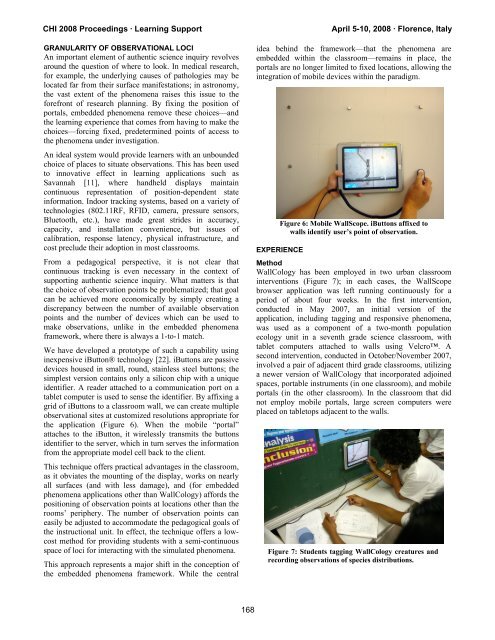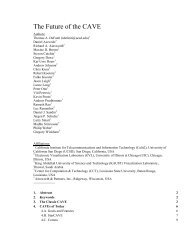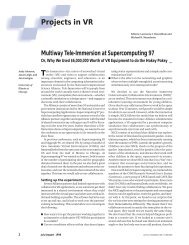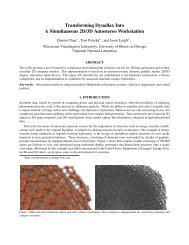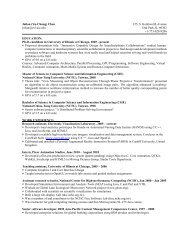pdf (27028 KB) - Electronic Visualization Laboratory - University of ...
pdf (27028 KB) - Electronic Visualization Laboratory - University of ...
pdf (27028 KB) - Electronic Visualization Laboratory - University of ...
Create successful ePaper yourself
Turn your PDF publications into a flip-book with our unique Google optimized e-Paper software.
CHI 2008 Proceedings · Learning Support April 5-10, 2008 · Florence, Italy<br />
GRANULARITY OF OBSERVATIONAL LOCI<br />
An important element <strong>of</strong> authentic science inquiry revolves<br />
around the question <strong>of</strong> where to look. In medical research,<br />
for example, the underlying causes <strong>of</strong> pathologies may be<br />
located far from their surface manifestations; in astronomy,<br />
the vast extent <strong>of</strong> the phenomena raises this issue to the<br />
forefront <strong>of</strong> research planning. By fixing the position <strong>of</strong><br />
portals, embedded phenomena remove these choices—and<br />
the learning experience that comes from having to make the<br />
choices—forcing fixed, predetermined points <strong>of</strong> access to<br />
the phenomena under investigation.<br />
An ideal system would provide learners with an unbounded<br />
choice <strong>of</strong> places to situate observations. This has been used<br />
to innovative effect in learning applications such as<br />
Savannah [11], where handheld displays maintain<br />
continuous representation <strong>of</strong> position-dependent state<br />
information. Indoor tracking systems, based on a variety <strong>of</strong><br />
technologies (802.11RF, RFID, camera, pressure sensors,<br />
Bluetooth, etc.), have made great strides in accuracy,<br />
capacity, and installation convenience, but issues <strong>of</strong><br />
calibration, response latency, physical infrastructure, and<br />
cost preclude their adoption in most classrooms.<br />
From a pedagogical perspective, it is not clear that<br />
continuous tracking is even necessary in the context <strong>of</strong><br />
supporting authentic science inquiry. What matters is that<br />
the choice <strong>of</strong> observation points be problematized; that goal<br />
can be achieved more economically by simply creating a<br />
discrepancy between the number <strong>of</strong> available observation<br />
points and the number <strong>of</strong> devices which can be used to<br />
make observations, unlike in the embedded phenomena<br />
framework, where there is always a 1-to-1 match.<br />
We have developed a prototype <strong>of</strong> such a capability using<br />
inexpensive iButton® technology [22]. iButtons are passive<br />
devices housed in small, round, stainless steel buttons; the<br />
simplest version contains only a silicon chip with a unique<br />
identifier. A reader attached to a communication port on a<br />
tablet computer is used to sense the identifier. By affixing a<br />
grid <strong>of</strong> iButtons to a classroom wall, we can create multiple<br />
observational sites at customized resolutions appropriate for<br />
the application (Figure 6). When the mobile “portal”<br />
attaches to the iButton, it wirelessly transmits the buttons<br />
identifier to the server, which in turn serves the information<br />
from the appropriate model cell back to the client.<br />
This technique <strong>of</strong>fers practical advantages in the classroom,<br />
as it obviates the mounting <strong>of</strong> the display, works on nearly<br />
all surfaces (and with less damage), and (for embedded<br />
phenomena applications other than WallCology) affords the<br />
positioning <strong>of</strong> observation points at locations other than the<br />
rooms’ periphery. The number <strong>of</strong> observation points can<br />
easily be adjusted to accommodate the pedagogical goals <strong>of</strong><br />
the instructional unit. In effect, the technique <strong>of</strong>fers a lowcost<br />
method for providing students with a semi-continuous<br />
space <strong>of</strong> loci for interacting with the simulated phenomena.<br />
This approach represents a major shift in the conception <strong>of</strong><br />
the embedded phenomena framework. While the central<br />
168<br />
idea behind the framework—that the phenomena are<br />
embedded within the classroom—remains in place, the<br />
portals are no longer limited to fixed locations, allowing the<br />
integration <strong>of</strong> mobile devices within the paradigm.<br />
Figure 6: Mobile WallScope. iButtons affixed to<br />
walls identify user’s point <strong>of</strong> observation.<br />
EXPERIENCE<br />
Method<br />
WallCology has been employed in two urban classroom<br />
interventions (Figure 7); in each cases, the WallScope<br />
browser application was left running continuously for a<br />
period <strong>of</strong> about four weeks. In the first intervention,<br />
conducted in May 2007, an initial version <strong>of</strong> the<br />
application, including tagging and responsive phenomena,<br />
was used as a component <strong>of</strong> a two-month population<br />
ecology unit in a seventh grade science classroom, with<br />
tablet computers attached to walls using Velcro. A<br />
second intervention, conducted in October/November 2007,<br />
involved a pair <strong>of</strong> adjacent third grade classrooms, utilizing<br />
a newer version <strong>of</strong> WallCology that incorporated adjoined<br />
spaces, portable instruments (in one classroom), and mobile<br />
portals (in the other classroom). In the classroom that did<br />
not employ mobile portals, large screen computers were<br />
placed on tabletops adjacent to the walls.<br />
Figure 7: Students tagging WallCology creatures and<br />
recording observations <strong>of</strong> species distributions.


